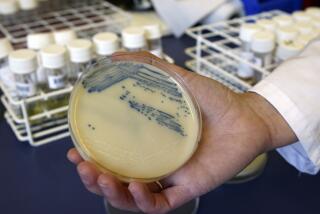Broader Bacteria Attack a Difficult Goal, Experts Say
- Share via
WASHINGTON — Even a terrorist who is able to expose people to anthrax through the mail would still face a number of difficulties launching a broader attack, according to experts in biological warfare.
Widely dispersing the bacteria would require considerably larger quantities of virulent, uniformly tiny and highly sophisticated forms of anthrax, a way to disseminate them effectively and favorable meteorological conditions.
“This becomes an order of magnitude far more difficult” than what we have seen thus far, said Elisa D. Harris, who served on the National Security Council and helped coordinate U.S. policy on biological and chemical weapon issues during the Clinton administration.
For a disease that has generated much anxiety across the country, anthrax has so far taken a small toll: one person dead and five others infected but expected to recover.
But concern about an attack that would produce mass casualties arose when anthrax bacteria mailed to the office of Senate Majority Leader Tom Daschle (D-S.D.) led to the exposure of 31 congressional staff members and security officers.
This was underscored when lawmakers described the anthrax in Daschle’s office as “sophisticated,” suggesting that whoever created it has the capability to make spores small enough to form a cloud that could harm many people by penetrating into their lungs.
Still, several scientists said Thursday, much remains unknown about this bacteria, which is being analyzed by army scientists.
Officials have yet to disclose the size or uniformity of the particles; the smaller and more uniform, the more likely they are to cover a larger area and infect more people. Neither have they said whether the spores were produced in such a way that they would not stick together. The spores have a natural tendency to do so, causing them to form a clump and fall to the ground, where they are unlikely to be inhaled.
Tiny anthrax spores of the same size that do not adhere to each other would raise new alarms.
“If they were all those things, then someone is very sophisticated in being able to produce things that threaten more people,” said Ronald Atlas, president-elect of the American Society for Microbiology and co-chair of its task force on biological weapons.
Raymond Zilinskas, a bioterrorism expert at the Monterey Institute of International Studies, said that anthrax in such a specialized form--a powder uniformly of five microns, for instance--could be sprayed into a public area with a device as rudimentary as a hand pump.
If a terrorist has such spores, he said, “we are in big trouble.”
The potential threat of anthrax to a large population was documented in a 1970 World Health Organization study that assessed the prospect of a military-type operation. The study estimated that 50 kilograms of anthrax spores released upwind from a city would infect 125,000 individuals and leave 95,000 dead.
Nothing thus far suggests that anyone has a large amount of finely ground anthrax.
David R. Franz, the former commander of the Army’s medical and biological defense laboratory, said that “if we found out there was a lot more of this around, then it would be much more likely that it would have come from a country with a bioweapons program.”
The U.S. has said that at least 13 countries have such programs. Iraq is known to have produced a weaponized form of anthrax, and the former Soviet Union made enormous amounts.
The World Health Organization study used other major assumptions that are unlikely to be replicated: The huge amount of bacteria was in a refined form that would be delivered under “ideal meteorological conditions” and victims would not be treated with antibiotics.
Winds can disperse the spores and sunlight can kill them, which makes the impact of an outdoor release difficult to control. Antibiotics are the normal, and usually effective, treatment for anthrax.
This could make a closed environment, such as a ventilation system or a subway, a more likely target.
Experts say that most buildings today would provide protection from the bacteria through a well-maintained heating, ventilation and air-conditioning system.
“If it gets into the ventilation system, the chances of being exposed are extremely low,” said James E. Woods, founding director of HP-Woods Research Institute and chairman of the environmental health committee of the American Society of Heating, Refrigerating and Air Conditioning Engineers.
The spores would be diluted as they pass through a complicated pathway of filters, cooling coils and ducts. The concentration of spores in air leaving the building through exhaust vents would, in turn, be insufficient to cause infection.
An enclosed subway system, said Atlas, “starts to remove some of the hurdles.” Such an attack would still require sufficient quantities in high enough concentrations for large numbers of passengers to each inhale the thousands of spores necessary to become infected.
Aum Supreme Truth, an apocalyptic Japanese cult, used a sprayer and a fan to release anthrax bacteria from atop an eight-story building in Tokyo during a four-day period in 1993 with no apparent effect. Analysts attributed the failure to the low virulence of the agent.
Two years later, the well-financed group unleashed a sarin nerve agent in a Tokyo subway at rush hour, killing 12 commuters and injuring more than 1,000.
*
Times researcher Janet Lundblad in Los Angeles contributed to this report.






